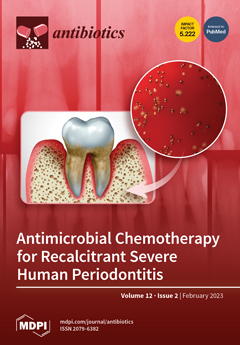Carbapenem-resistant
Acinetobacter baumannii (CRAB) isolates of global clone 1 (GC1) and global clone 2 (GC2) have been widely reported. Nevertheless, non-GC1 and non-GC2 CRAB strains have been studied less. In particular, no reports concerning sequence type 46 (ST46
Pas) CRAB strains have been described thus far. In this work, the genomic features and possible evolution mechanism of ST46
Pas OXA-23-producing CRAB isolates from clinical specimens are reported for the first time. Antimicrobial susceptibility testing of three ST46
Pas strains revealed identical resistance profiles (resistance to imipenem, meropenem, ciprofloxacin and the combination of cefoperazone/sulbactam at a 2:1 ratio). They were found to belong to ST46
Pas and ST462
Oxf with capsular polysaccharide 28 (KL28) and lipooligosaccharide 1 (OCL1), respectively. Whole-genome sequencing (WGS) revealed that all contained one copy of chromosomal
blaOXA-23, which was located in a novel IS
Aba1-based Tn
7534 composite transposon. In particular, another copy of the Tn
7534 composite transposon was identified in an Hgz_103-type plasmid with 9 bp target site duplications (TSDs, ACAACATGC) in the
A. baumannii ZHOU strain. As the strains originated from two neighboring intensive care units (ICUs), ST46
Pas OXA-23-producing CRAB strains may have evolved via transposition events or a p
dif module. Based on the GenBank database, ST46
Pas strains were collected from various sources; however, most were collected in Hangzhou (China) from 2014 to 2021. Pan-genome analysis revealed 3276 core genes, 0 soft-core genes, 768 shell genes and 443 cloud genes shared among all ST46
Pas strains. In conclusion, the emergence of ST46
Pas CRAB strains might present a new threat to healthcare settings; therefore, effective surveillance is required to prevent further dissemination.
Full article






